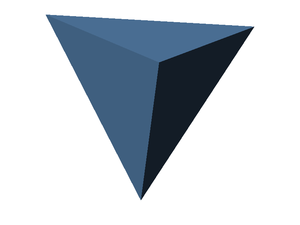Hard tetrahedron model: Difference between revisions
Jump to navigation
Jump to search
Carl McBride (talk | contribs) mNo edit summary |
Carl McBride (talk | contribs) m (Added a "water" publication.) |
||
| Line 1: | Line 1: | ||
{{stub-general}} | {{stub-general}} | ||
[[Image:tetrahedron.png|thumb|right]] | [[Image:tetrahedron.png|thumb|right]] | ||
The '''hard tetrahedron model'''. | The '''hard tetrahedron model'''. Such a structure has been put forward as a potential model for [[water]]<ref>[http://dx.doi.org/10.1080/00268979500100281 Jiri Kolafa and Ivo Nezbeda "The hard tetrahedron fluid: a model for the structure of water?", Molecular Physics '''84''' pp. 421-434 (1995)]</ref>. | ||
==Maximum packing fraction== | ==Maximum packing fraction== | ||
It has recently been shown that regular tetrahedra are able to achieve packing fractions as high as <math>\phi=0.8503</math><ref>[http://dx.doi.org/10.1038/nature08641 Amir Haji-Akbari, Michael Engel, Aaron S. Keys, Xiaoyu Zheng, Rolfe G. Petschek, Peter Palffy-Muhoray and Sharon C. Glotzer "Disordered, quasicrystalline and crystalline phases of densely packed tetrahedra", Nature '''462''' pp. 773-777 (2009)]</ref> (the [[hard sphere model |hard sphere]] packing fraction is <math>\pi/(3 \sqrt{2}) \approx 74.048%</math> <ref>[http://dx.doi.org/10.1038/26609 Neil J. A. Sloane "Kepler's conjecture confirmed", Nature '''395''' pp. 435-436 (1998)]</ref>). This is in stark contrast to work as recent as in 2006, where it was suggested that the "...regular tetrahedron might even be the convex body having the smallest possible packing density"<ref>[http://dx.doi.org/10.1073/pnas.0601389103 J. H. Conway and S. Torquato "Packing, tiling, and covering with tetrahedra", Proceedings of the National Academy of Sciences of the United States of America '''103''' 10612-10617 (2006)]</ref>. | It has recently been shown that regular tetrahedra are able to achieve packing fractions as high as <math>\phi=0.8503</math><ref>[http://dx.doi.org/10.1038/nature08641 Amir Haji-Akbari, Michael Engel, Aaron S. Keys, Xiaoyu Zheng, Rolfe G. Petschek, Peter Palffy-Muhoray and Sharon C. Glotzer "Disordered, quasicrystalline and crystalline phases of densely packed tetrahedra", Nature '''462''' pp. 773-777 (2009)]</ref> (the [[hard sphere model |hard sphere]] packing fraction is <math>\pi/(3 \sqrt{2}) \approx 74.048%</math> <ref>[http://dx.doi.org/10.1038/26609 Neil J. A. Sloane "Kepler's conjecture confirmed", Nature '''395''' pp. 435-436 (1998)]</ref>). This is in stark contrast to work as recent as in 2006, where it was suggested that the "...regular tetrahedron might even be the convex body having the smallest possible packing density"<ref>[http://dx.doi.org/10.1073/pnas.0601389103 J. H. Conway and S. Torquato "Packing, tiling, and covering with tetrahedra", Proceedings of the National Academy of Sciences of the United States of America '''103''' 10612-10617 (2006)]</ref>. | ||
Revision as of 15:29, 12 May 2010

The hard tetrahedron model. Such a structure has been put forward as a potential model for water[1].
Maximum packing fraction
It has recently been shown that regular tetrahedra are able to achieve packing fractions as high as [2] (the hard sphere packing fraction is [3]). This is in stark contrast to work as recent as in 2006, where it was suggested that the "...regular tetrahedron might even be the convex body having the smallest possible packing density"[4].
References
- ↑ Jiri Kolafa and Ivo Nezbeda "The hard tetrahedron fluid: a model for the structure of water?", Molecular Physics 84 pp. 421-434 (1995)
- ↑ Amir Haji-Akbari, Michael Engel, Aaron S. Keys, Xiaoyu Zheng, Rolfe G. Petschek, Peter Palffy-Muhoray and Sharon C. Glotzer "Disordered, quasicrystalline and crystalline phases of densely packed tetrahedra", Nature 462 pp. 773-777 (2009)
- ↑ Neil J. A. Sloane "Kepler's conjecture confirmed", Nature 395 pp. 435-436 (1998)
- ↑ J. H. Conway and S. Torquato "Packing, tiling, and covering with tetrahedra", Proceedings of the National Academy of Sciences of the United States of America 103 10612-10617 (2006)
Related reading

